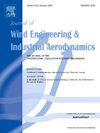高速列车制动系统中使用的相变材料的散热数值研究
IF 4.2
2区 工程技术
Q1 ENGINEERING, CIVIL
Journal of Wind Engineering and Industrial Aerodynamics
Pub Date : 2024-10-05
DOI:10.1016/j.jweia.2024.105911
引用次数: 0
摘要
高速列车制动系统的巨大散热需求对实现更高的运行速度构成了重大障碍。相变材料因其优异的散热性能在各个领域都引起了广泛关注,但其在高速列车制动系统中的应用仍有待探索。本研究旨在探讨相变材料在高速列车制动系统中应用的可行性。具体而言,在案例 A 中,相变材料的引入使制动系统内的平均温度显著降低了 21%,最大温差显著降低了 40%。相变材料的潜热在维持冷却组件与制动盘之间的巨大温差方面发挥了关键作用,从而提高了制动系统中的热通量。与制动系统中传统的空气冷却方法相比,相变材料的冷却性能更为出色。为了加快相变材料的冷却过程并促进其从液态到固态的转变,我们提出了一种利用相变材料的优化制动系统结构。这种优化设计有望提高高速列车制动系统的整体散热效率。本文章由计算机程序翻译,如有差异,请以英文原文为准。
Numerical investigation on the heat dissipation of phase change materials used in the high-speed train brake system
The massive heat dissipation demands of the brake system in high-speed trains pose a significant obstacle to achieving higher operation speeds. Phase change material has attracted considerable attention in various fields due to their exceptional heat dissipation capabilities, yet their utilization in the brake system of high-speed trains remains unexplored. This study aims to investigate the feasibility of phase change material application in the brake system of high-speed train. Specifically, in Case A, the introduction of phase change material resulted in a notable 21% decrease in the average temperature and a remarkable 40% reduction in the maximum temperature difference within the brake system. The latent heat of the phase change material plays a crucial role in maintaining a substantial temperature differential between the cooling components and discs, thereby enhancing heat flux in the brake system. Phase change materials exhibit superior cooling performance compared to traditional air cooling methods in the brake system. To expedite the cooling process of phase change material and facilitate its transition from liquid to solid, an optimized brake system structure utilizing phase change material was proposed. This optimized design holds promise in enhancing the overall heat dissipation efficiency of the high-speed train brake system.
求助全文
通过发布文献求助,成功后即可免费获取论文全文。
去求助
来源期刊
CiteScore
8.90
自引率
22.90%
发文量
306
审稿时长
4.4 months
期刊介绍:
The objective of the journal is to provide a means for the publication and interchange of information, on an international basis, on all those aspects of wind engineering that are included in the activities of the International Association for Wind Engineering http://www.iawe.org/. These are: social and economic impact of wind effects; wind characteristics and structure, local wind environments, wind loads and structural response, diffusion, pollutant dispersion and matter transport, wind effects on building heat loss and ventilation, wind effects on transport systems, aerodynamic aspects of wind energy generation, and codification of wind effects.
Papers on these subjects describing full-scale measurements, wind-tunnel simulation studies, computational or theoretical methods are published, as well as papers dealing with the development of techniques and apparatus for wind engineering experiments.

 求助内容:
求助内容: 应助结果提醒方式:
应助结果提醒方式:


